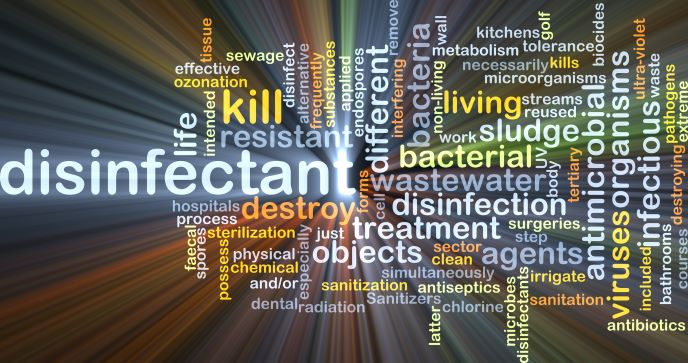Chemical Disinfection

Disinfection is a process that reduces the number of microorganisms present to a level at which they do not present a risk. Disinfection differs to sterilisation whereby the object is free of all viable microorganisms.
Chemical disinfectants do not generally kill all the microorganisms that they come in contact with and do not disinfect all microorganisms equally well, for example most do not kill bacterial spores. The type of disinfectant selected will depend on the microorganism, the method of application and the nature of the material to be disinfected.
Chemical disinfectants are applied to non-living objects and materials, such as surfaces and instruments to control and prevent infection, whilst antiseptics (a type of disinfectant) are applied to living tissues.
Factors to Consider
There are many factors to consider when selecting and using a chemical disinfectant:
- Efficacy: the disinfectant must work against the targeted microorganisms. Efficacy can be assessed using manufacturer’s literature, peer-reviewed literature and in-house testing.
- Concentration of disinfectant: the correct concentration must be used as per manufacturer’s instructions. Over dilution may result in the disinfectant not working against the target microorganism.
- Contact time: chemical disinfectants must be applied to the item they are disinfecting for sufficient time to enable the disinfection to work. The manufacturer’s instructions will detail the required time.
- Shelf life/Stability: many diluted disinfectants deteriorate with time. Once prepared diluted disinfectant should be dated with “use by” or “expiry dates” as per manufacturer’s instructions. Out of date stock or inactivated product will not provide effective disinfection.
- Presence of other contaminants: for example, proteins, organic matter, soaps, detergents can all reduce the effectiveness of the disinfectant. Oil and grease residues on surfaces may prevent effective contact with the disinfectant. Pre-cleaning of items is usually required for effective disinfection. However, this may not always be possible and in such cases disinfectants that remain active in the presence of considerable amounts of organic matter, longer contact times followed by removal of gross contamination and the reapplication of disinfectant etc. may be required if there is no other feasible alternative.
- pH and temperature: most disinfectants have an optimal pH and temperature for efficacy. In addition, high temperatures can increase evaporation of the disinfectant and reduce the contact time resulting in inadequate disinfection.
- Water hardness: can reduce the rate of kill of certain disinfectants.
- Compatibility: disinfectants must be compatible with the item being disinfected, for example, stainless steel can be damaged by strong acid and hypochlorite, whilst plastics can be affected by disinfectants containing organic solvents. In addition, some disinfectants may react with other chemicals releasing hazardous gases.
- Health hazards: many disinfectants are hazardous to health and may produce toxic or corrosive effects or induce an allergic sensitisation.
Incorrect use of disinfectants may contribute to increased resistance in microorganisms.
Safe Use of Disinfectants
- Obtain the Safety Data Sheet for the disinfectant and ensure it is accessible to the users of the disinfectant.
- Carry out a chemical risk assessment of the disinfectant and implement appropriate control measures to ensure safe use. Ensure the results of the risk assessment are brought to the attention of the relevant users of the disinfectant. Ensure any chemical incompatibilities are addressed in the risk assessment.
- Follow the manufacturer’s instructions to ensure correct use.
- Draw up a documented disinfection policy taking account of the manufacturer's instructions and the results of the chemical risk assessment. The policy should cover at a minimum:
- The specific type of disinfectant to use, its effective concentration, contact time and once made up how long it will be stable for.
- The target microorganisms for which the disinfectant is known to be effective (and ones for which it is not effective, if appropriate).
- What is suitable for disinfection and what is not suitable.
- Any hazards and risks associated with the disinfectant and how to use it safely, for example what personal protective equipment to wear.
- Safe disposal method for the disinfectant.
- Instruct and train employees on the correct and safe use and handling of disinfectants.
- Consider rotational use of disinfectants to prevent microorganism resistance.
Competent Authority
The Pesticide Registration and Control Divisions of the Department of Agriculture, Food and the Marine is the Competent Authority for biocidal products (which includes disinfectants) in Ireland.